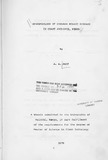| dc.contributor.author | Seif, AA | |
| dc.date.accessioned | 2013-05-25T11:00:22Z | |
| dc.date.available | 2013-05-25T11:00:22Z | |
| dc.date.issued | 1979 | |
| dc.identifier.citation | A thesis submitted in fulfilment for the Degree of Master of Science in the University of Nairobi. Department of Crop Science. Faculty of Agriculture. University of Nairobi. | en |
| dc.identifier.uri | http://erepository.uonbi.ac.ke:8080/xmlui/handle/123456789/25696 | |
| dc.description.abstract | Studies on the epidemiology of cassava
mosaic disease were conducted at the Coast
Agricultural Research Station (CARS>, Mtwapa
between the period 1976 to 1979. The results of
the investigations indicated that the development
of the mosaic in the field followed a .linear
relationship with time and was greatly influenced
by the direction of the prevailing winds. The
apparent rates of infection in the field on
different cassava varieties were generally low
(0.01 to 0.05 per unit per day) depending on the
varietal resistance to the causal agent of the
disease. Although the incidence of the disease
was observed to vary during the crop cycle
(10 - 12 months) prominent peaks of the disease
incidence occurred during the long and short
rains.
The whitefly vector was present on cassava
all the year round and there were marked fluctuations
in population build-up within a crop cycle.
Peaks in the whitefly population were observed
subsequent to rains and the development of adult
whitefly population was found to be highly
correlated (r = 0.697) with atmospheric temperature
{xiii}
and relative humidity. Rainfall was found to
have an indirect effect on the population
build-up of the vector as cassava produced new
flush of leaves on which the whiteflies preferred
to feed and rest.
There was a very high correlation (r - 0.912)
between the whitefly population and the incidence
of the cassava mosaic in the field. This explained
the coincidence of high population levels of the
vector and high incidence of the disease during
the period of the long and short rains.
Whitefly transmission of cassava mosaic
virus in the screen-house indicated that transmission
of the virus could result from feeding of
a single infective whitefly (11.0 per cent
transmission rate) but the number of successful
transmissions increased with the increase of the
number of the viruliferous whiteflies per plant
(15 - 20 insects per plant caused 56.08 per cent
transmission). It was also shown that there was
linear correlation between cassava mosaic disease
on all the varieties tested with dosage response
of the virus. This relationship was highly
significant (p L 0.01).
Out of the five cassava varieties evaluated
for their resistance to mosaic in the field and
in the screen-house, variety 53~8/34 was found to
be highly resistant, 46106/27 moderately resistant,
(xiv)
37244E susceptible and Aipin Valenca and N Mex 55
highly susceptible to cassava mosaic disease.
The difference in the level of resistance in the
varieties appeared to be inherent and quantitative
in nature. The method of vector transmission
in the screen-house was found to distinctly
\ separate the cassava varieties tested into
different resistance groups. This method could
prove useful to plant breeders for quick screening
of cassava material for mosaic resistance.
The average crop loss due to cassava mosaic
disease in the resistant cassava varieties
evaluated was 36.3 per cent. The difference in
yields between mosaic-free and mosaic-infected
treatments was highly significant (p L 0.01). | en |
| dc.language.iso | en | en |
| dc.title | Epidemiology of cassava mosaic disease in Coast province, Kenya | en |
| dc.type | Thesis | en |
| local.publisher | Plant Science & Crop Protection, University of Nairobi | en |

